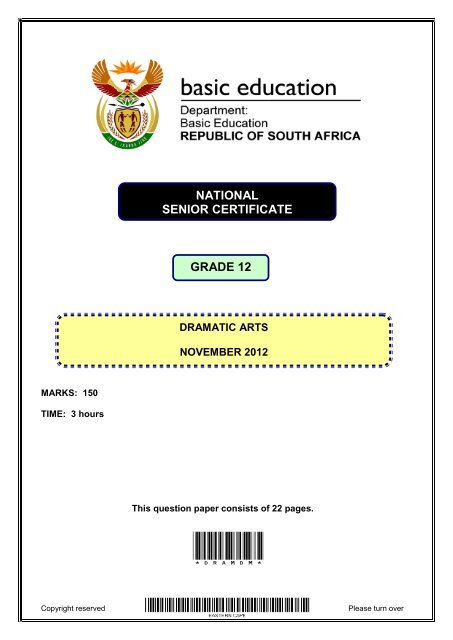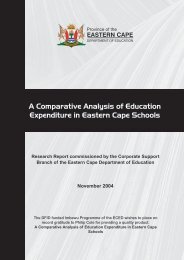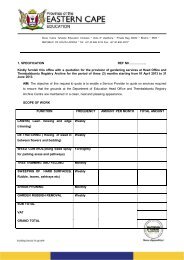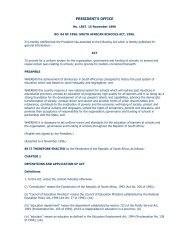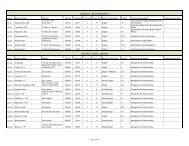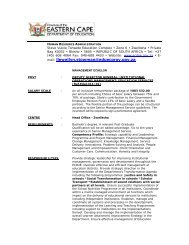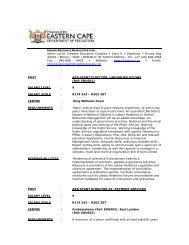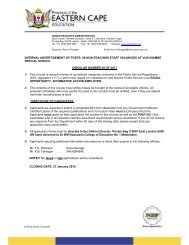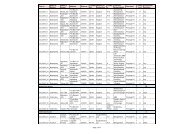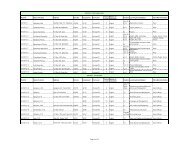Dramatic Arts Nov 2012 Eng.pdf
Dramatic Arts Nov 2012 Eng.pdf
Dramatic Arts Nov 2012 Eng.pdf
You also want an ePaper? Increase the reach of your titles
YUMPU automatically turns print PDFs into web optimized ePapers that Google loves.
GRAAD 12<br />
NATIONAL<br />
SENIOR CERTIFICATE<br />
GRADE 12<br />
DRAMATIC ARTS<br />
NOVEMBER <strong>2012</strong><br />
MARKS: 150<br />
TIME: 3 hours<br />
This question paper consists of 22 pages.<br />
*DRAMDM*<br />
Copyright reserved<br />
Please turn over
<strong>Dramatic</strong> <strong>Arts</strong> 2 DBE/<strong>Nov</strong>ember <strong>2012</strong><br />
NSC<br />
INSTRUCTIONS AND INFORMATION<br />
1. ANSWER ONLY THE QUESTIONS ON THE DRAMATIC TEXTS YOU HAVE<br />
STUDIED.<br />
2. You have been allocated FIFTEEN minutes reading time before the start of<br />
the examination.<br />
3. This question paper consists of THREE sections.<br />
SECTION A<br />
SECTION B<br />
SECTION C<br />
(30 marks)<br />
(60 marks)<br />
(60 marks)<br />
4. SECTION A consists of TWO questions:<br />
QUESTION 1:<br />
QUESTION 2:<br />
Epic Theatre<br />
(Caucasian Chalk Circle, Mother Courage or Kanna Hy Kô<br />
Hystoe)<br />
Theatre of the Absurd<br />
(Waiting for Godot, The Bald Primadonna or Bagasie)<br />
Answer only ONE question from SECTION A.<br />
5. SECTION B consists of EIGHT questions:<br />
• QUESTION 3 (Boesman and Lena)<br />
• QUESTION 4 (uNosilimela)<br />
• QUESTION 5 (Woza Albert!)<br />
• QUESTION 6 (Sophiatown)<br />
• QUESTION 7 (Nothing but the Truth)<br />
• QUESTION 8 (Groundswell)<br />
• QUESTION 9 (Siener in die Suburbs)<br />
• QUESTION 10 (Missing)<br />
Answer only TWO questions from SECTION B.<br />
6. SECTION C consists of THREE questions.<br />
QUESTION 11 and QUESTION 12 are COMPULSORY.<br />
From QUESTION 13, answer any ONE of the three questions:<br />
QUESTION 13.1 OR QUESTION 13.2 OR QUESTION 13.3.<br />
7. Number the answers correctly according to the numbering system used in this<br />
question paper.<br />
8. Pay attention to the number of marks allocated to each question.<br />
9. Use your classroom knowledge, as well as independent and creative thinking,<br />
to answer the questions.<br />
10. Write neatly and legibly.<br />
Copyright reserved<br />
Please turn over
<strong>Dramatic</strong> <strong>Arts</strong> 3 DBE/<strong>Nov</strong>ember <strong>2012</strong><br />
NSC<br />
SECTION A: UNDERSTAND AND ANALYSE<br />
Answer EITHER QUESTION 1: EPIC THEATRE OR QUESTION 2: THEATRE OF<br />
THE ABSURD.<br />
QUESTION 1: EPIC THEATRE<br />
Answer this question if you have studied Caucasian Chalk Circle OR Mother Courage<br />
OR Kanna Hy Kô Hystoe.<br />
Brecht defined his Epic Theatre as challenging the dream world where all problems are<br />
carefully resolved; he wanted a spectator who was awake and alert. His theatre posed<br />
problems and, far from solving them, was designed to leave the audience with the task<br />
of finding solutions.<br />
Discuss in an essay how the Epic techniques and the themes used in the Epic play<br />
you have studied this year encouraged the audience to be aware and critical of<br />
society's problems. [30]<br />
OR<br />
QUESTION 2: THEATRE OF THE ABSURD<br />
Answer this question if you have studied Waiting for Godot OR The Bald Primadonna<br />
OR Bagasie.<br />
Absurd Theatre was surreal, illogical, conflictless and plotless. The dialogue often<br />
seemed to be complete gibberish. And, not surprisingly, the public's first reaction to<br />
this new theatre was incomprehension and rejection.<br />
(Jerome P Crabbe)<br />
Explain in a detailed essay how the statement above is true of the Absurdist genre.<br />
You may include the following in your answer:<br />
• Philosophy of Theatre of the Absurd<br />
• Characteristics/Features of Theatre of the Absurd<br />
• Structure of plays<br />
• Dialogue used in plays<br />
You must use specific examples from the play text to support your answer. [30]<br />
TOTAL SECTION A: 30<br />
Copyright reserved<br />
Please turn over
<strong>Dramatic</strong> <strong>Arts</strong> 4 DBE/<strong>Nov</strong>ember <strong>2012</strong><br />
NSC<br />
SECTION B: UNDERSTAND AND ANALYSE<br />
Answer only TWO questions from this section.<br />
QUESTION 3: BOESMAN AND LENA BY ATHOL FUGARD<br />
Read the extract from Boesman and Lena below and answer the questions that follow.<br />
LENA:<br />
BOESMAN:<br />
LENA:<br />
BOESMAN:<br />
LENA :<br />
BOESMAN:<br />
LENA:<br />
BOESMAN:<br />
Aikona! I'll go to the police.<br />
You tried that before and what happened? 'She's my woman, baas.<br />
Net a bietjie warm gemaak.' 'Take her' … finish en klaar. They know<br />
the way it is with our sort.<br />
Not this time! My name is Mary, remember. 'Don't know this man,<br />
baas.' So where is your proof.<br />
[Holding up a clenched fist] Here!<br />
Oppas! You'll go too far one day. Death penalty.<br />
For you? [Derisive laughter.] Not guilty and discharge.<br />
Don't talk big. You're frightened of the rope. When you stop hitting it's<br />
not because you're moeg or had enough. You're frightened! Ja.<br />
[Pause]<br />
Ja. That's when I feel it most. When you do it carefully. The last few …<br />
when you aim. I count them. One … another one … wait for the next<br />
one! He's only resting.<br />
You're right, Boesman. That's proof. When I feel it I'll know. I'm Lena.<br />
[Emphatically] And I'm Boesman.<br />
1<br />
5<br />
10<br />
15<br />
3.1 Explain why Athol Fugard chose to use a mixture of languages in the extract<br />
above. (4)<br />
3.2 Study lines 2–4.<br />
Copyright reserved<br />
3.2.1 Why did the police at that time not take Lena's complaints of abuse<br />
seriously? (4)<br />
3.2.2 How does Boesman's dialogue in these lines highlight his attitude<br />
towards abuse and domestic violence? (4)<br />
3.2.3 This play was first produced on 10 July 1969 and reflected<br />
attitudes that were prevalent at that time.<br />
Do you think that the attitude of the police towards abuse and<br />
domestic violence has changed since then? Give reasons for your<br />
answer. (4)<br />
3.3 Why does Lena not carry out her threat of leaving Boesman? (3)<br />
3.4 Describe the stage type that would suit a production of Boesman and Lena.<br />
Give a reason for your answer. (3)<br />
3.5 'Lena is Boesman's victim and Boesman is society's victim.'<br />
Discuss how the extract reveals the validity (truth) of the statement above.<br />
Refer to the extract and the text as a whole. (8)<br />
[30]<br />
Please turn over
<strong>Dramatic</strong> <strong>Arts</strong> 5 DBE/<strong>Nov</strong>ember <strong>2012</strong><br />
NSC<br />
QUESTION 4: uNOSILIMELA BY CREDO MUTWA<br />
Read the extract from uNosilimela below and then answer the questions that follow.<br />
STORYTELLER:<br />
The storyteller. The umuzi of Magadlemzini is set on the iThala. The<br />
actors populate it as the storyteller narrates. Women are busy at<br />
various household chores; men sharpen, carve, decorate weapons,<br />
drink, chat, etc.<br />
No more in the mists of legend but the living present, where in the<br />
south-west of Natal, on the banks of the Nkomazi River, there live<br />
the amaQhashi, who have been at war with the amaDedevu for<br />
over a hundred years. The amaQhashi are ruled by their king,<br />
Magadlemzini, who loves nothing more than to lie in the sun<br />
pretending to be sick. His great wife is Namdozolwana oyinyumba,<br />
barren sangoma, guardian of the cave of the Earth Mother.<br />
iThala/Inkundla. Magadlemzini's umuzi. The amaQhashi is singing a<br />
satirical song about Namdozolwana, while one of the women stands<br />
guard.<br />
1<br />
5<br />
10<br />
14<br />
4.1 uNosilimela contains elements of mythology.<br />
Identify a myth from the text and explain how it enhances (adds to) the<br />
structure and style of the play. (4)<br />
4.2 In the play uNosilimela, the storyteller assumes the position of God the<br />
Creator.<br />
4.2.1 How does the storyteller help the audience to understand the play<br />
better? (2)<br />
4.2.2 How would you dress the storyteller to represent 'the image of<br />
God'? (2)<br />
4.2.3 Imagine that you have been cast to play the role of the storyteller.<br />
Explain how you would present lines 5–11 using any TWO<br />
attributes of speech (inflection, volume, pitch, pace, pause and<br />
emphasis) to present the character of the storyteller effectively. (4)<br />
4.3 Explain how you might use any THREE props to enhance the performance of<br />
the play. Motivate your answer. (6)<br />
4.4 Carefully study the stage ground plan of uNosilimela on the next page and<br />
answer the questions that follow.<br />
Copyright reserved<br />
Please turn over
<strong>Dramatic</strong> <strong>Arts</strong> 6 DBE/<strong>Nov</strong>ember <strong>2012</strong><br />
NSC<br />
A<br />
U<br />
D<br />
I<br />
E<br />
N<br />
C<br />
E<br />
3.<br />
LIFE<br />
AREA<br />
AUDIENCE<br />
1.<br />
SPIRIT AREA<br />
5.<br />
Ishashalazi<br />
2.<br />
HIGH<br />
AREA<br />
6<br />
4.<br />
Inkundla<br />
3.<br />
LIFE<br />
AREA<br />
AUDIENCE<br />
A<br />
U<br />
D<br />
I<br />
E<br />
N<br />
C<br />
E<br />
STAGE AREAS<br />
1. Spirit Area<br />
Stage area for the supernatural<br />
Cave and/or Ithala<br />
Sacred enclosure reserved for God<br />
2. High Area<br />
Area where story is introduced<br />
3. Life Area<br />
Stage area where main events take<br />
place and audience/performers are<br />
seated<br />
4. Inkundla<br />
Stage where dramatic action is<br />
concluded<br />
5. Ishashalazi<br />
Additional stage for main performance<br />
6. Entrance and Exit<br />
Only entrance for both actors and<br />
audience<br />
[© Endlini kaGogo: IKS in Contemporary Context by Phil Manana 2010]<br />
4.4.1 Why is the audience made to sit around some of the acting areas? (4)<br />
4.4.2 State ONE advantage of this type of staging. (2)<br />
4.4.3 Discuss ONE limitation of this type of staging. (2)<br />
4.4.4 What sounds and other special effects could you use to reflect the<br />
sacred (holy) nature of the Ithala/cave? (4)<br />
[30]<br />
Copyright reserved<br />
Please turn over
<strong>Dramatic</strong> <strong>Arts</strong> 7 DBE/<strong>Nov</strong>ember <strong>2012</strong><br />
NSC<br />
QUESTION 5:<br />
WOZA ALBERT! BY PERCY MTWA, MBONGENI NGEMA AND<br />
BARNEY SIMON<br />
Read the extract from a review by Lesley Stones of the play Woza Albert! below and<br />
then answer the questions that follow.<br />
This is an extremely physical piece of theatre, with actors Mncedisi Shabangu and<br />
Hamilton Dlamini dashing around in tackies and tracksuit bottoms. They're quickly<br />
drenched in sweat, partly because the air conditioning failed and partly because the<br />
play is so demanding. It's amazing how much noise two men can make, as they imitate<br />
prison sirens, trains, barking dogs and a dozen other sounds of daily life of the streets<br />
of Joburg.<br />
1<br />
5<br />
The play by Percy Mtwa, Mbongeni Ngema and Barney Simon is stuffed with wit and<br />
satire. Shabangu and Dlamini play a variety of characters to highlight the inequalities of<br />
life when whites had it all and blacks picked up the scraps.<br />
Pink clown noses turn them into Afrikaners, emphasising the point in a subversive<br />
(rebellious) and a visual way.<br />
Both actors bristle with skill and vigour, and Shabangu's amazing facial expressions<br />
really touch the heart. Playing an old tattered tramp, he gallantly tries to thread a<br />
needle to repair his threadbare coat. The audience clapped spontaneously when the<br />
imaginary thread finally went through the imaginary needle.<br />
10<br />
15<br />
5.1 Would you be encouraged to watch a performance of the play Woza Albert!<br />
after reading this review? Motivate your answer. (4)<br />
5.2 Explain why the performance of this play is described as an 'extremely<br />
physical piece of theatre'. Give TWO reasons. (4)<br />
5.3 Explain why and how the actors use their bodies as instruments of<br />
performance to create various characters and the sounds in the play. (6)<br />
5.4 'The audience clapped spontaneously when the imaginary thread finally went<br />
through the imaginary needle' (lines 14–15).<br />
What acting technique is used here and why was it necessary to use this<br />
method? (3)<br />
5.5 Explain why Woza Albert! is a good example of a protest play. (3)<br />
5.6 Discuss TWO themes, with examples from the play, that draw attention to the<br />
'inequalities of life when whites had it all and blacks picked up the scraps'<br />
(lines 8–9). (10)<br />
[30]<br />
Copyright reserved<br />
Please turn over
<strong>Dramatic</strong> <strong>Arts</strong> 8 DBE/<strong>Nov</strong>ember <strong>2012</strong><br />
NSC<br />
QUESTION 6: SOPHIATOWN BY THE JUNCTION AVENUE THEATRE COMPANY<br />
Refer to the sources below and answer the questions that follow.<br />
SOURCE A<br />
B C<br />
A<br />
A production photo of Sophiatown showing the extract in SOURCE B<br />
SOURCE B<br />
(The household breaks into a celebratory song.)<br />
A bo tle<br />
Re ba kakqathe<br />
Ga bo pala<br />
Re bo tsho lole (x 2)<br />
(Let it come<br />
We'll drink it<br />
If it doesn't taste nice<br />
We'll throw it out) (x 2)<br />
1<br />
5<br />
RUTH:<br />
FAFHEE:<br />
RUTH:<br />
FAFHEE:<br />
JAKES:<br />
(RUTH fetches bottles of gin, brandy and whiskey, hidden in brownpaper<br />
packets. LULU hands out glasses. The song gets raucous. RUTH<br />
interrupts.)<br />
I've got a surprise! Along with the usual gift from the Yeoville shops: a<br />
bottle of special home-made Jewish Friday night wine.<br />
What?<br />
I thought we might all like to try it. It's specially made for Friday night,<br />
and today's Friday, so here we are. Who knows, the entire house may<br />
be miraculously converted.<br />
Three drops of this Jewish wine and we're all Softown Majietas.<br />
Com'on then, let's hit that bottle.<br />
(He opens the wine and pours.)<br />
Right everybody, take a glass. We'll drink a toast in Jewish wine to the<br />
Jewish girl. And here's hoping for an instant rise in circulation.<br />
10<br />
15<br />
20<br />
Copyright reserved<br />
Please turn over
<strong>Dramatic</strong> <strong>Arts</strong> 9 DBE/<strong>Nov</strong>ember <strong>2012</strong><br />
NSC<br />
6.1 Identify characters A, B and C on the production photo. (3)<br />
6.2 Why does the household break out in a celebratory song in line 1? (3)<br />
6.3 What was the purpose of including songs in the play Sophiatown? (4)<br />
6.4 Explain how Ruth, a white girl, ended up living in Mamariti's shebeen and<br />
what does this say about her character? (4)<br />
6.5 In this scene all the characters are enjoying themselves.<br />
Describe, in a paragraph, another scene from the play where the mood and<br />
atmosphere are completely different. (5)<br />
6.6 The play Sophiatown was created by the Junction Avenue Theatre Company.<br />
6.6.1 Name the process used to create this play. (1)<br />
6.6.2 Briefly describe THREE phases in the creation process. (6)<br />
6.6.3 How might this method of creating plays benefit a theatre<br />
company? (4)<br />
[30]<br />
Copyright reserved<br />
Please turn over
<strong>Dramatic</strong> <strong>Arts</strong> 10 DBE/<strong>Nov</strong>ember <strong>2012</strong><br />
NSC<br />
QUESTION 7: NOTHING BUT THE TRUTH BY JOHN KANI<br />
Study the sources below and then answer the questions that follow.<br />
SOURCE A<br />
A production photo of Nothing but the Truth showing the extract in SOURCE B<br />
SOURCE B<br />
SIPHO:<br />
MANDISA:<br />
SIPHO:<br />
MANDISA:<br />
SIPHO:<br />
THANDO:<br />
SIPHO:<br />
MANDISA:<br />
SIPHO:<br />
MANDISA:<br />
SIPHO:<br />
MANDISA:<br />
SIPHO:<br />
MANDISA:<br />
SIPHO:<br />
MANDISA:<br />
The funeral! Oh, my God! The funeral! What are we going to do?<br />
What about the night vigil? Reverend Haya is coming to conduct a<br />
small service for the arrival of Themba's body. What body? How could<br />
you do this to me? Why didn't your mother say anything to me?<br />
My mother wrote to you, Uncle Sipho, and you never replied. Anyway,<br />
I don't see the problem. That's what everybody does in <strong>Eng</strong>land.<br />
You burnt my brother.<br />
Don't say burnt. He was cremated, and that was my mother's wish.<br />
Your mother's wish. You burnt him to ashes.<br />
Daddy, please!<br />
(Pointing to the urn): What is in this thing?<br />
His ashes.<br />
All of him.<br />
Some of him.<br />
Where is the rest?<br />
You don't take all the ashes from the oven. It's symbolic. The rest is<br />
… discharged is the word they use.<br />
You mean thrown away?<br />
All right. Yes.<br />
I want them all.<br />
Oh, this is ridiculous. I didn't come here to argue about ashes.<br />
1<br />
5<br />
10<br />
15<br />
20<br />
Copyright reserved<br />
Please turn over
<strong>Dramatic</strong> <strong>Arts</strong> 11 DBE/<strong>Nov</strong>ember <strong>2012</strong><br />
NSC<br />
7.1 By describing the set and costumes in SOURCE A, explain how it enhances<br />
(adds to) the realistic genre of the play. (6)<br />
7.2 Explain why the urn on the table (SOURCE A) is a source of conflict in this<br />
scene. (4)<br />
7.3 Refer to the extract in SOURCE B.<br />
How would you direct an actor portraying Sipho vocally and physically to draw<br />
attention to his emotional state in lines 1–4? (6)<br />
7.4 Discuss the cultural differences between Mandisa and Sipho which are<br />
evident in the extract above and the play as a whole. (6)<br />
7.5 Discuss the relevance that a play like Nothing but the Truth has in society by<br />
referring to the characters, dialogue and subject matter. (8)<br />
[30]<br />
Copyright reserved<br />
Please turn over
<strong>Dramatic</strong> <strong>Arts</strong> 12 DBE/<strong>Nov</strong>ember <strong>2012</strong><br />
NSC<br />
QUESTION 8: GROUNDSWELL BY IAN BRUCE<br />
Refer to the sources below and answer the questions that follow.<br />
THAMI:<br />
JOHAN:<br />
THAMI:<br />
JOHAN:<br />
THAMI:<br />
JOHAN:<br />
THAMI:<br />
JOHAN:<br />
THAMI:<br />
JOHAN:<br />
THAMI:<br />
JOHAN:<br />
THAMI:<br />
JOHAN:<br />
THAMI:<br />
JOHAN:<br />
THAMI:<br />
JOHAN:<br />
THAMI:<br />
JOHAN:<br />
THAMI:<br />
SOURCE A<br />
There are men in the informal settlement of Rooikamp who will sell you a<br />
diamond for the price of a white pipe or a papsak.<br />
That's who you've been talking to?<br />
My parcel is growing fatter month by month. Week by week, in fact.<br />
(Shocked) You're lying.<br />
No.<br />
You're lying. Where's it?<br />
Safe.<br />
Why didn't you tell me about it before?<br />
Why should I tell you? So you can tell me it's wrong, and I must rather<br />
wait until you can get a jackpot?<br />
I thought you were my friend, my partner.<br />
I can't be that.<br />
(Johan fetches the knife, approaches Thami.)<br />
I wanted to help you, Thami. I wanted to make things right for you.<br />
I don't need you to do that for me.<br />
(Struck) No, don't say that.<br />
I don't need you for anything.<br />
(Shows the knife) I'm warning you, I'll –<br />
I know what you'll do.<br />
Don't make me.<br />
Don't make you what? Kill an unarmed man? Why not? That's what you<br />
can do.<br />
I didn't mean to –<br />
But you did! You killed a man who couldn't protect himself.<br />
SOURCE B<br />
1<br />
5<br />
10<br />
15<br />
20<br />
25<br />
A production photo of Groundswell showing the extract in SOURCE A<br />
Copyright reserved<br />
Please turn over
<strong>Dramatic</strong> <strong>Arts</strong> 13 DBE/<strong>Nov</strong>ember <strong>2012</strong><br />
NSC<br />
8.1 Which performance style would be most appropriate for this play? (1)<br />
8.2 Describe the set that one might use to support the performance style of the<br />
play. (6)<br />
8.3 What does Thami mean in line 11 when he speaks about a 'jackpot'? (3)<br />
8.4 Study line 25.<br />
8.4.1 What event is Thami referring to in this line? (2)<br />
8.4.2 Discuss how Thami's statement highlights the theme of guilt and<br />
redemption. (4)<br />
8.5 In lines 5 and 7 Johan repeats the words 'You're lying'.<br />
How would you direct the actor performing the role of Johan to deliver these<br />
lines vocally and physically to highlight the growing tension between the two<br />
characters? (4)<br />
8.6 Refer to the photo in SOURCE B.<br />
Although Johan is holding a knife, Thami's body language does not convey<br />
fear.<br />
Explain the shift in power in between Johan and Thami that culminates in the<br />
final confrontation between them. (6)<br />
8.7 Read the excerpt from a review of Groundswell below and then answer the<br />
question that follows.<br />
Post-apartheid South Africa may seem far away from here, but the tale that<br />
unravels in Groundswell (which is set there), is one many audience members<br />
may relate to quite easily. Written by Ian Bruce, this thriller follows three men<br />
who traverse a tightrope of greed and desperation in a chaotic scheme.<br />
(Diana Saenger)<br />
Do you agree that audience members would enjoy the play even if they did<br />
not know the history of apartheid? Motivate your answer. (4)<br />
[30]<br />
Copyright reserved<br />
Please turn over
<strong>Dramatic</strong> <strong>Arts</strong> 14 DBE/<strong>Nov</strong>ember <strong>2012</strong><br />
NSC<br />
QUESTION 9: SIENER IN DIE SUBURBS BY PG DU PLESSIS<br />
9.1 The characters in the play find themselves in a very specific social<br />
environment where a distinction is made between the upper and lower worlds<br />
of the suburbs.<br />
9.1.1 Name ONE character that belongs to the upper world of the<br />
suburbs and say why he/she is placed there. (3)<br />
9.1.2 In which world would you place the character of Sybil? Give a<br />
reason for your answer. (2)<br />
SOURCE A<br />
The characters strive to escape from the misery of a precarious existence.<br />
(Ernst Lindenberg from his review 'Siener is Remarkable')<br />
9.2 Discuss how the character of Tiemie reflects someone who is striving to<br />
escape from the 'misery of a precarious existence' (struggling to live). (10)<br />
SOURCE B<br />
9.3 Read the extract below from the play and answer the questions that follow.<br />
JAKES:<br />
FÉ:<br />
GIEL:<br />
JAKES :<br />
GIEL:<br />
JAKES:<br />
GIEL:<br />
JAKES:<br />
Kom, laat die oues van dae 'n slukkie drink.<br />
Sies! (Sy gaan staan by die motor.)<br />
Nee, skink maar, ou vriend.<br />
(Skink) Vir die soetgeit en die bloedgeit<br />
En die cherries se rondgeit<br />
En die halfjack se kleingeit<br />
En die moeilikgeit …<br />
(Hulle drink.)<br />
Jy moenie van moeilikheid praat nie, Jakes. Ek is in 'n lelike ding.<br />
Jy dink jý't moeilikheid! Jy moet myne hoor.<br />
Dis 'n ernstige ding wat ek in is. Ek praat nou baie waar.<br />
Orraait, let money talk. As jy groter moeilikheid het as ek, gee ek jou 'n<br />
kas van dié. Kom ons drink eers 'n lekka dikke op die ding.<br />
Ons versuip ons moeilikhede. Vrydag is Vrydag. (Hy skink weer.)<br />
Hier gaat die moeilikheid.<br />
1<br />
5<br />
10<br />
15<br />
9.3.1 In the extract above Giel and Jakes say that they have 'trouble'<br />
('moeilikheid'). Explain Giel's 'trouble'. (3)<br />
9.3.2 You are playing the character of Jakes. Explain how you would<br />
perform lines 1, 4–7 and 10 vocally and physically to make Jakes's<br />
conversation with Giel engaging (to hold the audience's attention). (6)<br />
Copyright reserved<br />
Please turn over
<strong>Dramatic</strong> <strong>Arts</strong> 15 DBE/<strong>Nov</strong>ember <strong>2012</strong><br />
NSC<br />
9.3.3 You are the director of Siener in die Suburbs.<br />
Draw the sketch below in your ANSWER BOOK and show, with<br />
reasons, where you would place/position the characters Jakes, Fé<br />
and Giel during their conversation in the extract above.<br />
Make use of the following key when indicating where you would<br />
position the characters:<br />
• J = Jakes<br />
• F = Fé<br />
• G = Giel<br />
STAGE<br />
AUDIENCE<br />
(6)<br />
[30]<br />
Copyright reserved<br />
Please turn over
<strong>Dramatic</strong> <strong>Arts</strong> 16 DBE/<strong>Nov</strong>ember <strong>2012</strong><br />
NSC<br />
QUESTION 10: MISSING BY REZA DE WET<br />
10.1 Study the sources and answer the questions that follow.<br />
SOURCE A<br />
A photo taken during the Great Depression (1929–1933)<br />
10.1.1 Describe the social and economic conditions of the Great<br />
Depression that form the background of the play Missing. (4)<br />
10.1.2 Explain how EACH of the following characters has been influenced<br />
by the Great Depression:<br />
• Miem<br />
• Gabriel<br />
• Meisie<br />
(3)<br />
(3)<br />
(3)<br />
Copyright reserved<br />
Please turn over
<strong>Dramatic</strong> <strong>Arts</strong> 17 DBE/<strong>Nov</strong>ember <strong>2012</strong><br />
NSC<br />
SOURCE B<br />
10.2 Read the extract below and answer the questions that follow.<br />
GERTIE:<br />
MIEM:<br />
GERTIE:<br />
MIEM:<br />
GERTIE:<br />
MIEM:<br />
MEISIE:<br />
MIEM:<br />
GERTIE:<br />
MIEM:<br />
MEISIE:<br />
GERTIE:<br />
Ag, Miem. Tonight's no time to be alone!<br />
(Sighs and sits down.) You can say that again. (She picks up her<br />
sacking and sews.)<br />
I was just thinking how big my garden is and how far away my<br />
neighbours are … and then, in the quiet … I heard … noises. The whole<br />
house started creaking … and the shutters banged. It was awful.<br />
Shame, Gertie. Not surprising though. (Lifts her foot and rests it on a<br />
chair)<br />
And then I heard an owl screech in the garden. You know what the old<br />
people say … well, I just threw a few things together and … I'm sorry to<br />
arrive on your doorstep like this!<br />
You did the right thing, Gertie. We all have to stand together tonight.<br />
I heard an owl last night. In the tree outside my window.<br />
My poor girl. But don't you worry.<br />
I don't want to be any trouble.<br />
No trouble at all, Gertie. You can sleep on the camp bed in my room.<br />
Meisie, take miss Gertie's things to the room.<br />
Yes, Ma. (She picks up the hat and case and exits through the passage<br />
door.)<br />
(Calling after her) Thanks, Meisie.<br />
(A soft, moaning wind can be heard.)<br />
1<br />
5<br />
10<br />
15<br />
19<br />
10.2.1 Why does Gertie say 'tonight's no time to be alone' (line 1)? (2)<br />
10.2.2 Traditionally the screech of an owl is a sign of evil.<br />
Explain how the references to owls connect to the theme of<br />
exorcism in Missing in the extract above. (4)<br />
10.2.3 Discuss how the playwright Reza de Wet uses the sound of the<br />
wind to convey atmosphere and meaning in Missing. Refer to the<br />
extract above and the play as a whole. (6)<br />
10.2.4 You are playing the role of Gertie. Explain how you would perform<br />
lines 9–11 vocally and physically to create the mood and<br />
atmosphere evident in these lines. (5)<br />
[30]<br />
TOTAL SECTION B: 60<br />
Copyright reserved<br />
Please turn over
<strong>Dramatic</strong> <strong>Arts</strong> 18 DBE/<strong>Nov</strong>ember <strong>2012</strong><br />
NSC<br />
SECTION C: APPLY PERSONAL RESOURCES AND REFLECT AND EVALUATE<br />
SECTION C is COMPULSORY.<br />
QUESTION 11<br />
Read the monologue from Mr Matwetwe by Thembile Pepetka below and answer the<br />
questions that follow.<br />
MR MATWETWE:<br />
Then … I saw a group of young boys, I suddenly returned to my<br />
earthly senses, in a panic I hid the bible under my jacket, but it<br />
was too late … One of them screamed 'Impimpi! (Spy) a walkietalkie<br />
under his jacket!' They chased me with pangas, sticks,<br />
stones. I dropped the bible while I was running … confused,<br />
crying for my life, I ran to this house (running around the stage)<br />
they closed the door, I ran to this house they closed the door, I<br />
ran to this one they closed the door, they all closed their doors<br />
because they didn't want to be contaminated (infected) by my<br />
disease. Down there at Mbizweni Square I saw a hippo (army<br />
vehicle), I thought God was with me, I ran to the hippo, but then it<br />
pulled off, the so-called protectors of my township went away.<br />
The only thing I remember after that was, I was tired, (kneels<br />
down) they put a tyre round my neck, added cold petrol over my<br />
body and set me alight.<br />
1<br />
5<br />
10<br />
15<br />
11.1 Imagine that you had to present the monologue above as part of your Theme<br />
Programme.<br />
Describe TWO exercises you would use to prepare your voice and body to<br />
deliver such a serious monologue. (4)<br />
11.2 Explain how vocal variety can be used in the monologue above to create the<br />
sense of growing fear and panic that Mr Matwetwe is feeling. (6)<br />
11.3 Ellipses (...) are found in lines 1, 3 and 5.<br />
What do you suggest should happen where these ellipses occur, and why? (2)<br />
11.4 Suggest what the other members in your group should be doing while you are<br />
delivering this monologue. (3)<br />
[15]<br />
Copyright reserved<br />
Please turn over
<strong>Dramatic</strong> <strong>Arts</strong> 19 DBE/<strong>Nov</strong>ember <strong>2012</strong><br />
NSC<br />
QUESTION 12<br />
Refer to the sources below and answer the questions that follow.<br />
SOURCE A<br />
12.1 Would you consider the performance in SOURCE A to be an example of<br />
Physical Theatre? Motivate your answer. (3)<br />
12.2 Explain whether you would prefer to watch a physical theatre performance or<br />
a performance of a traditional play. (4)<br />
12.3 How would having an all-male or an all-female cast affect the presentation<br />
of a physical theatre performance? Motivate your answer. (4)<br />
12.4 The body speaks more eloquently (powerfully) than words.<br />
Why would this statement be true for the performance in SOURCE A?<br />
Motivate your answer. (6)<br />
Copyright reserved<br />
Please turn over
<strong>Dramatic</strong> <strong>Arts</strong> 20 DBE/<strong>Nov</strong>ember <strong>2012</strong><br />
NSC<br />
SOURCE B<br />
12.5 Study the picture in SOURCE B.<br />
Do you think that the use of costumes would enhance the presentation of a<br />
movement piece? (3)<br />
12.6 Discuss TWO skills/qualities a learner would need in order to perform in the<br />
movement piece shown above. (4)<br />
12.7 Discuss THREE factors that you and your group took into consideration in the<br />
planning and preparation of your movement piece. (6)<br />
[30]<br />
Copyright reserved<br />
Please turn over
<strong>Dramatic</strong> <strong>Arts</strong> 21 DBE/<strong>Nov</strong>ember <strong>2012</strong><br />
NSC<br />
QUESTION 13<br />
Answer ONE of the following three questions, that is QUESTION 13.1 OR<br />
QUESTION 13.2 OR QUESTION 13.3.<br />
Your answer should be a minimum of ONE page in length.<br />
13.1 LIVE PERFORMANCE (CHOICE QUESTION)<br />
The audience is the most revered member of the theatre. Without an<br />
audience, there is no theatre. Everything done is ultimately for the enjoyment<br />
of the audience. They are our guests, fellow players, and the last spoke in the<br />
wheel which can then begin to roll. They make the performance meaningful.<br />
(Viola Spolin)<br />
Discuss the validity of the statements above by stating the impact the<br />
audience has on the actor and his performance.<br />
In your answer, refer to:<br />
• Performances you have watched<br />
• Your own experience of performing<br />
• Theatre practitioners you have studied [15]<br />
OR<br />
13.2 MEDIA STUDIES (CHOICE QUESTION)<br />
Reality shows like Big Brother, Survivor, Idols, America's Got Talent, et<br />
cetera, have become very popular with audiences today. These shows appeal<br />
to people because of the dream to make it big, to have their names in bright<br />
lights, to be celebrities and to be famous. In the end, the ordinary man is<br />
forgotten and only the sponsors win.<br />
Discuss the popularity of reality shows and explain why they appeal to<br />
ordinary people.<br />
In your answer, refer to:<br />
• Techniques used (for example the use of celebrities)<br />
• Audience participation<br />
• Media hype [15]<br />
OR<br />
Copyright reserved<br />
Please turn over
<strong>Dramatic</strong> <strong>Arts</strong> 22 DBE/<strong>Nov</strong>ember <strong>2012</strong><br />
NSC<br />
13.3 CULTURAL PERFORMANCE AND RITUAL (CHOICE QUESTION)<br />
'Ayibukelwa!' (SiSwati) [No spectators allowed!] 'Ayibukelwa' is an EmaSwati<br />
proverb that specifically refers to the indigenous iNcwala [self-fortification<br />
ceremony] which discourages spectatorship during the performance. In<br />
indigenous performances the audience is expected to mingle with the actors<br />
and take part in the performance. There is no distinction between the actor<br />
and the spectator.<br />
Discuss the validity of the statement above.<br />
In your answer, refer to:<br />
• The ceremony above<br />
• Any other cultural ceremony that you practise or are familiar with<br />
• The relationship between the actor and the audience [15]<br />
TOTAL SECTION C: 60<br />
GRAND TOTAL: 150<br />
Copyright reserved


